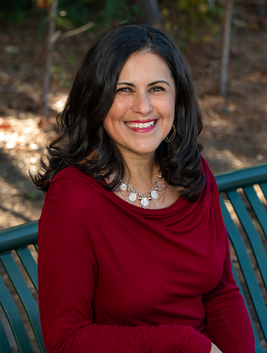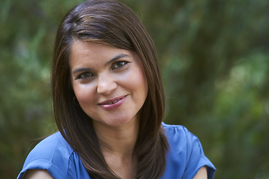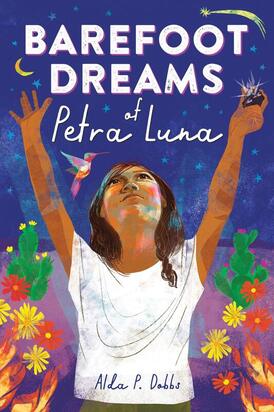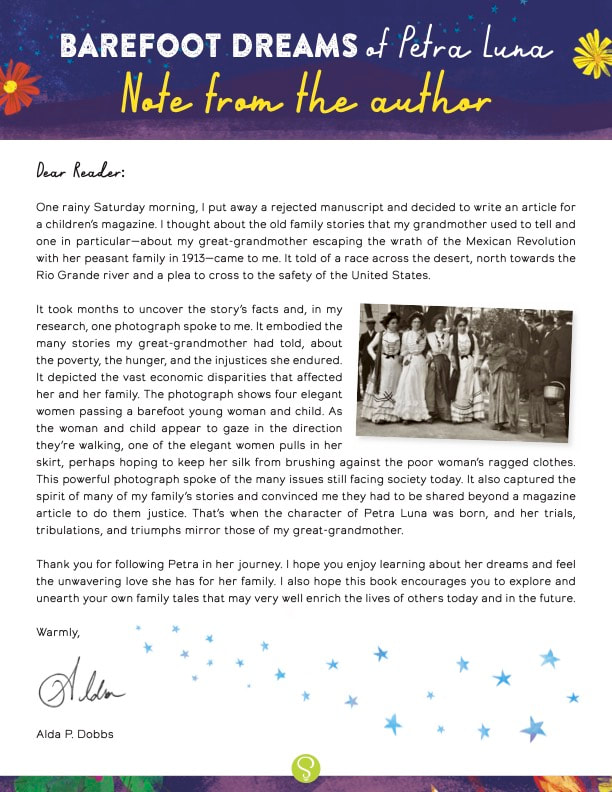|
We’re so thrilled to celebrate the release of Alda P. Dobbs’s middle-grade debut, Barefoot Dreams of Petra Luna. We have a great interview between Musas Alda P. Dobbs and Anika Fajardo, along with Alda's letter to the reader, but first a little about the book!
AF: Congratulations on your debut middle-grade novel, Alda! AD: Thank you, Anika! I’m a big fan of your beautiful middle grade, What If A Fish, and it’s such an honor to be interviewed by you! AF: Thank you so much. Can you tell us a bit about your book in your own words? AD: Sure! It is 1913, and twelve-year-old Petra Luna's mama has died while the Revolution rages in Mexico. Before Petra’s papa is dragged away by soldiers, Petra vows that she will care for the family she has left―her abuelita, little sister Amelia, and baby brother Luisito―until they can be reunited. They flee north through the unforgiving desert as their town burns, searching for safe harbor in a world that offers none. Each night when Petra closes her eyes, she holds her dreams close, especially her long-held desire to learn to read. Abuelita calls these barefoot dreams: "They're like us barefoot peasants and indios―they're not meant to go far." But Petra refuses to listen. Through battlefields and deserts, hunger and fear, Petra will stop at nothing to keep her family safe and lead them to a better life across the U.S. border―a life where her barefoot dreams can finally become reality. AF: What inspired you to tell Petra's story? AD: Growing up I loved listening to many family stories about my great-grandmother’s experiences during the Mexican Revolution. They all told of extraordinary events and unbelievable trials she endured as a child. One story in particular intrigued me. It was about my great-grandmother and her family anxiously waiting along with thousands of other people for the US border to open so that they could cross into safety. I decided to do some research to find out if it was true. Without having an exact date, I searched through old newspapers and, after many months of research (and almost giving up!), I found an article that described the event exactly as my great-grandmother had recounted it. I knew then I had to share her story, and Petra Luna was born! AF: That is amazing. Historical fiction is so compelling and requires a lot of research. Can you tell us a little more about researching the Mexican Revolution? AD: My goodness, a lot of research went into this book. I read nearly every book, both in English and Spanish, on the Mexican Revolution as I attempted to prove the accuracy of my family story but found nothing. After months of reading these academic books and almost giving up, a wonderful librarian (Mr. Tim Blevins at Pikes Peak Library System) introduced me to a portal that included all the newspapers printed in Texas during that era. Not having an exact date of the event, I searched through old newspapers and, after six or seven months, I found an article that depicted the event. I researched many other things, even the most mundane, and some never made it into the book but it allowed me to know the characters and setting intimately. I researched the Mexican Revolution, desert plants, curanderismo, Aztec mythology, Náhuatl, music from that era, etc. I also printed out segments of Sanborn maps and assembled them together like puzzle pieces to let me know what streets Petra Luna had walked on. When I cross-referenced the map with old photographs, I could see buildings she came across and even walked into. I kept a timeline handy that followed actual dates chronicled in newspapers to help weave in the fiction. AF: I love old maps! So how do you see Petra's story in context with children today? AD: In my book, Petra’s dreams, and her way of seeing the world are often at odds with her grandmother’s views. Young readers will see that differences in perspectives between generations is a universal theme that transcends time. Readers can also see how Petra’s journey to escape violence in her homeland and reach the safety of the United States is something that is relevant today or might even have happened in their own ancestors. Finally, Petra’s story demonstrates the strength that kids have. They do not have to sit by and let the world run over them; they are strong enough to change their personal situation or their families or the world! AF: Now that your book is going out into the world, what's been the best or most surprising thing about being a debut author? AD: I’d have to say that despite how incredibly busy you get, there’s so much JOY and FULFILLMENT working with your editor and the various teams within your publishing house. It’s incredible to see all the collaboration to bring a new book into the world. Also, the encouragement and new friendships you develop with fellow authors is priceless. Thank you so much for sharing more about your debut! Now scroll on to read Alda's note to the reader!  Alda P. Dobbs is the author of Barefoot Dreams of Petra Luna (Sourcebooks, Fall 2021). Her writings have won various awards including the Barbara Deming Memorial Fund Award and the Sustainable Arts Foundation Grant. She has also written articles for Highlights Children’s Magazine, Guideposts, and La Prensa newspaper. Alda was born in a small town in northern Mexico but moved to San Antonio, Texas, as a child. She studied physics and worked as an engineer before pursuing her love of storytelling. She is as passionate about connecting children to their past, their communities, different cultures, and nature as she is about writing. Alda lives with her husband and two children outside Houston, Texas. Find her at aldapdobbs.com.  Anika Fajardo was born in Colombia and raised in Minnesota. She is the author of the memoir, MAGICAL REALISM FOR NON-BELIEVERS. Her debut middle-grade novel is WHAT IF A FISH (Simon & Schuster, 2020), and her second novel MEET ME HALFWAY will be published in 2022. A writer, editor, and teacher, she lives in Minneapolis. Find her at anikafajardo.com
0 Comments
Leave a Reply. |
Las Musas SpeakWelcome to our blog! Archives
July 2024
Categories
All
|



 RSS Feed
RSS Feed